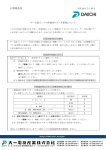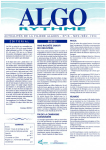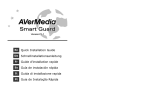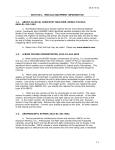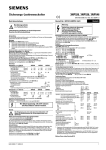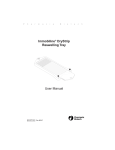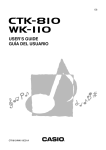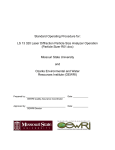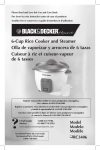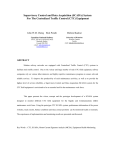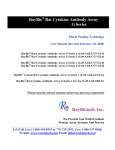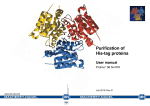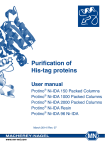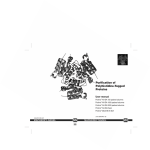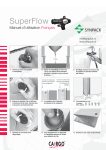Download CLONTECH
Transcript
CLONTECH Innovative Tools to Accelerate Discovery TALONTM Metal Affinity Resins User Manual PT1320-1 (PR16704) Published 01 October 2001 See List of Components for storage conditions FOR RESEARCH USE ONLY TALON TM Metal Affinity Resins User Manual Table of Contents I. Introduction 4 II. List of Components 8 III. Additional Materials Required 9 TALONTM IV. Buffers for V. Transformation & Protein Expression 14 VI. General Considerations 15 A. General Information 15 B. Choosing the buffers: imidazole vs. pH gradient 16 C. Elution strategy: step vs. linear gradients 16 D. Reusing TALON Resins 16 E. TALON CellThru Considerations 17 F. Protein Purification methods using TALON 17 Sample Preparation 20 A. Sample Preparation to Isolate Native Proteins 20 B. Sample Preparation to Isolate Denatured Proteins 21 C. TALON CellThru Sample Preparation 21 VII. Purification & Buffer Kits 13 VIII. Protein Purification Protocols 22 A. Batch/Gravity-Flow Column Purification 22 B. Large-Scale Batch Purification 23 C. Medium-Pressure Column Purification using TALON Superflow 24 D. TALONspin Column Purification 25 Resin Washing, Reuse, and Storage 28 Troubleshooting Guide 29 XI. References 33 XII. Related Products 34 IX. X. Appendix A. Reagent Compatibilities and Incompatibilities 35 Appendix B. Mini-Scale Protein Purification Protocol 36 Appendix C. Vector Information 38 CLONTECH Laboratories, Inc. 2 www.clontech.com Protocol # PT1320-1 Version # PR16704 TALON TM Metal Affinity Resins User Manual Table of Contents continued List of Figures Figure 1. Schematic diagram of the TALON IMAC System. 5 Figure 2. Elution mechanism of recombinant polyhistidine-tagged proteins from TALON Resin. 6 Figure 3. Binding of histidines to TALON’s metal ion. 6 Figure 4. Purification of polyhistidine-tagged proteins using TALON. 11 Figure 5. pHAT10/11/12 combined vector map and MCS. 38 Figure 6. pHAT20 combined vector map and MCS. 39 List of Tables Table I. TALON resin characteristics 18 Table II. 19 Protein purification using TALON products. Table III. Reagent Compatibility 35 Notice to Purchaser: The use of TALONTM products are covered under U.S. Patent #5,962,641. HATTM, TALONTM ,TALONspinTM, TALON-NXTM, and ProTetTM are trademarks of CLONTECH Laboratories, Inc. Sepharose® is a registered trademark of Pharmacia LKB Biotechnology. Triton® is a registered trademark of Rohm and Haas Co. Superflow TM and UniflowTM are trademarks of Sterogene Bioseparations, Inc. This product is intended to be used for research purposes only. It is not to be used for drug or diagnostic purposes nor is it intended for human use. CLONTECH products may not be resold, modified for resale, or used to manufacture commercial products without written approval of CLONTECH. © 2001, CLONTECH Laboratories, Inc. All rights reserved. Protocol # PT1320-1 Version # PR16704 www.clontech.com CLONTECH Laboratories, Inc. 3 TALON TM Metal Affinity Resins User Manual I. Introduction Proteins have evolved very complex structures in order to perform a diverse array of functions. As a result, their physicochemical properties vary greatly, posing difficulties for developing versatile purification protocols. One way to circumvent this problem is to incorporate a purification tag into the primary amino acid sequence of a target protein, thus constructing a recombinant protein with a binding site that allows purification under well-defined, generic conditions. Immobilized Metal Affinity Chromatography (IMAC) IMAC was introduced in 1975 as a group-specific affinity technique for separating proteins (Porath et al., 1975). The principle is based on the reversible interaction between various amino acid side chains and immobilized metal ions. Depending on the immobilized metal ion, different side chains can be involved in the adsorption process. Most notably, histidine, cysteine, and tryptophan side chains have been implicated in protein binding to immobilized transition metal ions and zinc (Figure 1, Porath, 1985; Sulkowski, 1985; Hemdan & Porath, 1985a; Hemdan & Porath, 1985b; Zhao et al., 1991). TALONTM IMAC Resins TALONTM Resins are durable, cobalt-based IMAC resins designed to purify recombinant polyhistidine-tagged proteins (Bush et al., 1991). These resins are compatible with many commonly used reagents (Appendix A), and allow protein purification under native or denaturing conditions. They can be used with all prokaryotic and eukaryotic expression systems in a variety of formats, including small- (or mini-) scale batch screening, large-scale batch preparations, and methods using gravity-flow columns and spin columns. In addition, protocols used with Ni+2-based IMAC columns usually work with TALON resins. Tetradentate metal chelator To overcome the problem of metal leakage encountered with other IMAC resins, TALON utilizes a special tetradentate metal chelator for purifying recombinant polyhistidine-tagged proteins (U.S. Patent #5,962,641). This chelator tightly holds the electropositive metal in an electronegative pocket (Figure 1), which is ideal for binding metal ions such as cobalt. The binding pocket is an octahedral structure in which four of the six metal coordination sites are occupied by the TALON ligand. This process enhances TALON’s protein binding capacity by making the bound metal ion accessible to surrounding polyhistidine-tagged proteins. The tetradentate metal binding means that no metal loss occurs during protein purification under recommended conditions, even in the presence of strong denaturants such as 6 M guanidinium. Such durability allows TALON to be reused. Cobalt IMAC Resin permits milder elution conditions TALON exhibits subtle yet important differences in binding of polyhistidinetagged proteins when compared with nickel IMAC resins. For example, nickelbased IMAC resins often exhibit an undesirable tendency to bind unwanted host CLONTECH Laboratories, Inc. 4 www.clontech.com Protocol # PT1320-1 Version # PR16704 TALON TM Metal Affinity Resins User Manual I. Introduction continued COO– H2C Sepharose Bead N COO– HC Co2+ N N COO– H2C N N A B Figure 1. Schematic diagram of the TALONTM IMAC System. Part A. TALON Metal Affinity Resin; A Sepharose bead bearing the tetradentate chelator of the Co2+ metal ion. Part B. The polyhistidinetagged recombinant protein binds to the resin. proteins containing exposed histidine residues (Kasher et al., 1993). While TALON binds polyhistidine-tagged proteins with enhanced selectivity over nickel-based resins, it exhibits a significantly reduced affinity for host proteins. This behavior offers two practical advantages. First, virtually no background proteins are bound to TALON when the sample is applied; consequently, cumbersome washing procedures are not generally required before protein elution. Second, polyhistidine-tagged proteins elute from TALON under slightly less stringent conditions—a slightly higher pH or lower imidazole concentration—than with nickel IMAC resins. Elution occurs when the imidazole nitrogen (pKa of 5.97) is protonated (Figure 2), generating a positively charged ammonium ion, which is repelled by the positively charged metal atom. Alternatively, the bound polyhistidine-tagged protein can be competitively eluted by simply adding imidazole to the elution buffer, because imidazole is identical to the histidine side chain. Polyhistidine affinity tags Histidines exhibit highly selective coordination with certain transition metals and have great utility in IMAC. Under conditions of physiological pH, histidine binds by sharing electron density of the imidazole nitrogen with the electron-deficient orbitals of transition metals (Figure 3). Although three histidines may bind transition metals under certain conditions, six histidines reliably bind transition metals in the presence of strong denaturants such as guanidinium (Hochuli et al., 1987). Such protein tags are commonly referred to as “6xHis,” “hexaHis,” or “(His)6.” Protocol # PT1320-1 Version # PR16704 www.clontech.com CLONTECH Laboratories, Inc. 5 TALON TM Metal Affinity Resins User Manual I. Introduction continued N H + N H N N H H+ N Unprotonated Histidine binds to metal N 2+ Protonated Histidine repelled by metal N Figure 2. Elution mechanism of recombinant polyhistidine-tagged proteins from TALON Resin. Elution occurs when the imidazole nitrogen (pKa = 5.97) is protonated, generating a positively charged ammonium ion which is repelled by the positively charged metal ion. Alternatively, the bound polyhistidine-tagged protein can be competitively eluted by adding imidazole to the elution buffer. N Figure 3. Binding of histidines to TALON’s metal ion. Under conditions of physiological pH, histidine binds by sharing imidazole nitrogen electron density with the electron-deficient orbitals of the metal ion. HATTM —a novel IMAC affinity tag With the advent of recombinant genetic technologies, the design and production of recombinant proteins containing novel polyhistidine tags on their N- or Ctermini has become more straightforward (Hochuli et al., 1987; Hochuli et al., 1988). The HAT sequence (patent pending) is a novel IMAC affinity tag derived from a unique natural protein sequence (Chaga et al., 1999). It contains six histidines unevenly interleaved by other amino acid residues (see Appendix C). The HAT amino acid sequence is derived from the N-terminus of chicken muscle lactate dehydrogenase—a sequence that is unique among reported protein sequences. The novel tag does not have the excessive positive charge characteristic of the commonly used 6xHis tag, thus contributing to better solubility of HAT-fusion proteins and similar affinity towards immobilized transition metal ions and zinc. CLONTECH offers the HATTM Protein Expression and Purification System (#K6050-1)—a complete system containing reagents and vectors designed for bacterial expression and purification of HAT (histidine affinity tag) proteins. Each of the three vectors—pHAT10, pHAT11, and pHAT12—contain a multiple cloning site (MCS) in all three frames to allow cloning of target cDNA. (For vector map and MCS, see Appendix C of this User Manual.) A conveniently located enterokinase proteolytic site between the HAT sequence and the MCS provides a means for removing the affinity tag. For more information, see the HAT Expression & Purification System User Manual (PT3250-1), which can be downloaded from our web site at www.clontech.com. CLONTECH Laboratories, Inc. 6 www.clontech.com Protocol # PT1320-1 Version # PR16704 TALON TM Metal Affinity Resins User Manual I. Introduction continued Overview of TALONTM Resins The following is a list of different formats that can meet your purification needs. • TALONTM Metal Affinity Resin is useful for batch and low-pressure chromatographic applications. TALON Resin utilizes Sepharose® CL-6B (Pharmacia LKB Biotechnology), a durable substrate that performs very well under native and denaturing conditions in centrifuge-mediated purification schemes. The large pore size resin has a high-binding capacity. • TALONTM Superflow Resin is useful for a range of applications, including medium pressure applications with FPLC systems at back pressures of up to 150 psi (1 MPa) and high flow rates up to 5 ml per cm2 per min. This resin is recommended if short purification times are essential, or if purification protocols developed at bench scale will be scaled up for larger volumes. TALON Superflow utilizes SuperflowTM-6 (Sterogene Bioseparations, Inc.), an agarose-based medium featuring a unique polysaccharide composition that resists biological degradation. Superflow-6 beads are also stabilized by a chemical cross-linking reaction that allows flow rates up to 10 times higher than are possible with regular cross-linked beads. • TALONTM CellThru is a novel IMAC resin for purifying polyhistidine-tagged proteins from crude cell lysates, sonicates, and fermentation liquids. The larger bead size of TALON CellThru (300–500 µm) permits cellular debris to flow through the column, eliminating the need for high-speed centrifugation. With TALON CellThru, destabilizing factors are removed more quickly than with other resins, because the number of steps are reduced. CellThru 2-ml & 10-ml Disposable Columns have a large filter pore size (90– 130 µm) that allows cellular debris to flow through the column during the purification process. The 2-ml columns are suitable for 1–2 ml bed volumes, while the 10-ml columns are suitable for 5–10 ml bed volumes. • TALONspinTM Columns are ideal for rapidly and simultaneously purifying small amounts of polyhistidine-tagged proteins. TALONspin Columns are recommended for single-use applications or for use as mini gravity-flow columns. Each column contains 0.5 ml of TALON-NXTM Resin, which is optimized for performance in a spin column. Each column will yield 2–4 mg of polyhistidine-tagged protein; exact yields will vary with conditions used and polyhistidine-tagged protein characteristics. In addition, yield and purity will depend upon expression level and lysate concentration. Beginning with the clarified sample, the entire procedure takes approximately 30 minutes. Protocol # PT1320-1 Version # PR16704 www.clontech.com CLONTECH Laboratories, Inc. 7 TALON TM Metal Affinity Resins User Manual II. List of Components TALON, TALON Superflow, and TALON CellThru are supplied as 50% (w/v) slurries in nonbuffered 20% ethanol. Please note that during shipping and storage, the resin will settle; thus, we recommend that you thoroughly resuspend it before aliquotting. 2 ml of homogeneously resuspended resin will provide 1 ml of TALON Resin with a binding capacity of at least 5 mg of polyhistidine-tagged protein. Store TALON Resins, TALONspin Columns and TALON Buffers at 4°C. Do not freeze. • TALONTM Metal Affinity Resin Cat. # Amount 8901-1 10 ml 8901-2 25 ml 8901-3 100 ml 8901-4 250 ml • TALONTM Superflow Resin Cat. # Amount 8908-1 25 ml 8908-1 100 ml • TALONspinTM Columns (#8902-1, -2, -3, -4) These columns contain 0.5 ml of TALON-NXTM resin as a 50% suspension in nonbuffered 20% ethanol. • TALONTM CellThru Cat. # Amount 8910-1 10 ml 8910-2 100 ml • TALONTM CellThru Disposable Columns Size Cat # 2-ml column (#8914-1) 10-ml column (#8915-1) • TALONTM Purification Kit (#K1253-1) 10 ml TALONTM Metal Affinity Resin 160 ml 5X Extraction/Wash Buffer 160 ml (250 mM Sodium Phosphate, 1.5 M Sodium Chloride, pH 7) 5X Extraction Buffer 25 ml (250 mM Sodium Phosphate, 1.5 M Sodium Chloride, pH 8) 10X Elution Buffer 5 1 (1.5 M Imidazole, pH 7) 2-ml Disposable Gravity Columns 10-ml Disposable Gravity Column CLONTECH Laboratories, Inc. 8 www.clontech.com Protocol # PT1320-1 Version # PR16704 TALON TM Metal Affinity Resins User Manual II. List of Components continued • TALONTM Buffer Kit (#K1252-1) 160 ml 5X Extraction/Wash Buffer 160 ml 25 ml (250 mM Sodium Phosphate, 1.5 M Sodium Chloride, pH 7) 5X Extraction Buffer (250 mM Sodium Phosphate, 1.5 M Sodium Chloride, pH 8) 10X Elution Buffer (1.5 M Imidazole, pH 7) • TALONTM 2-ml Disposable Gravity Columns (#8903-1) III. Additional Materials Required If you have not purchased the TALON Purification Kit (#K1253-1) or the TALON Buffer Kit (#K1252-1), we recommend preparing the following buffers for purifying polyhistidine-tagged proteins under native or denaturing conditions. See Section IV for preparing buffers with TALON Purification Kit or Buffer Kit. Before preparing other buffer compositions, please consult Appendix A to evaluate resin compatibility. Choosing Buffers To decrease the amount of nonspecifically bound proteins, we recommend using the Extraction/Wash Buffer at pH 7.0 during purification; however, if your target protein is more stable at pH 8.0, or if it does not adsorb at pH 7.0, use the Extraction Buffer at pH 8.0 (in place of the Extraction/Wash Buffer) during all extraction and wash steps. Note that at elevated pH values, amino acids other than histidine, as well as the peptide bond, contribute to protein adsorption. Thus, proteins without a polyhistidine tag can also adsorb to TALON Resins, which decreases resin capacity and the final purity of your target protein. You may choose to use either native or denaturing buffer conditions, depending on the solubility of your protein. Figure 4 outlines the TALON purification procedure. A. Native Buffers Native protein purification regimens use buffer conditions that preserve the native, three-dimensional structure and surface charge characteristics of a selected soluble protein during harvest from an expression host. TALON’s low affinity for nonpolyhistidine-tagged proteins minimize contaminant carryover. In addition, increasing buffer ionic strength can minimize nonspecific interactions. Regardless of the conditions used and the nature of the polyhistidine-tagged protein being purified, most applications will benefit from the presence of 100–500 mM NaCl in the IMAC buffer. In many cases, adding glycerol or ethylene glycol neutralizes nonspecific hydrophobic interactions. Small amounts of nonionic detergent may also dissociate weakly bound species. Protocol # PT1320-1 Version # PR16704 www.clontech.com CLONTECH Laboratories, Inc. 9 TALON TM Metal Affinity Resins User Manual III. Additional Materials Required continued • Phosphate buffered saline (PBS; pH 7.5) Final conc. To prepare 2 L of solution Na2HPO4 58 mM 16.5 g NaH2PO4 17 mM 4.1 g NaCl 68 mM 8.0 g B. Dissolve the above components in 1.8 L of deionized H 2O. Adjust to pH 7.5 with 0.1 N NaOH. Add deionized H 2O to final volume of 2 L. Store at room temperature • 1X Extraction/Wash buffer (pH 7.0) 50 mM Sodium Phosphate 300 mM NaCl • 1X Extraction buffer (pH 8.0) 50 mM Sodium Phosphate 300 mM NaCl • 1X Elution buffer (See also Section VI.B) – Imidazole Elution (pH 7.0) – pH Elution (pH 5.0) 50 mM Sodium Phosphate 50 mM Sodium Acetate 300 mM NaCl 300 mM NaCl 150 mM Imidazole Denaturing Buffers Denaturants, such as 6 M guanidinium, enhance protein solubility. Because proteins overexpressed in prokaryotic systems are sometimes insoluble, you may need to purify proteins under denaturing conditions. When purifying proteins under denaturing conditions, we recommend preparing buffers, indicated below. In the presence of 6 M guanidinium, TALON’s color will change from a pinkish-mauve to violet due to a change in metal ion hydration in response to the chaotrope. After removal of the chaotrope, TALON will return to a pinkish-mauve color. The change to violet does not reflect any change in the physical or chemical properties of the resin. In fact, the color change can be useful for indicating the buffer in which the resin is suspended, and for following the movement of guanidinium through the resin bed. • 1X Extraction/Wash buffer (pH 7.0) 50 mM Sodium Phosphate 6 M Guanidine-HCl 300 mM NaCl CLONTECH Laboratories, Inc. 10 www.clontech.com Protocol # PT1320-1 Version # PR16704 TALON TM Metal Affinity Resins User Manual III. Additional Materials Required continued Native purification of soluble polyhistidine-tagged protein Denaturing purification of insoluble polyhistidine-tagged protein Equilibrate resin Apply to TALON resin Wash nonadsorbed material Wash Elute Imidazole elution pH elution Buffer at pH 5.0 Imidazole elution Buffer at pH 7.0 + 150 mM imidazole, 5.4 M guanidinium Buffer at pH 7.0 + 150 mM imidazole Pure native protein Pure denatured protein Figure 4. Purification of polyhistidine-tagged proteins using TALONTM . The protocols in this User Manual are designed using the Extraction/Wash Buffer at pH 7.0. If your target protein is more stable at pH 8.0, or if it does not adsorb at pH 7.0, use the Extraction Buffer (pH 8.0) instead of the Extraction/Wash Buffer during the extraction and wash steps. Protocol # PT1320-1 Version # PR16704 www.clontech.com CLONTECH Laboratories, Inc. 11 TALON TM Metal Affinity Resins User Manual III. Additional Materials Required continued • 1X Extraction buffer (pH 8.0) 50 mM Sodium Phosphate 6 M Guanidine-HCl 300 mM NaCl • 1X Imidazole Elution buffer (pH 7.0) 45 mM Sodium Phosphate 5.4 M Guanidine-HCl 270 mM NaCl 150 mM Imidazole C. Additional Buffers & Reagents • MES Buffer 20 mM 2-(N-morpholine)-ethanesulfonic acid (MES), pH 5.0 • 5X SDS PAGE sample buffer 15% β-Mercaptoethanol (β-ME) 15% SDS 50% Glycerol 1.5% Bromophenol blue • Imidazole (Sigma, Cat. # I0250) for FPLC Applications D. Additional Materials required for TALONTM CellThru • CellThru 2-ml Disposable Columns (#8914-1) • CellThru 10-ml Disposable Columns (#8915-1) CLONTECH Laboratories, Inc. 12 www.clontech.com Protocol # PT1320-1 Version # PR16704 TALON TM Metal Affinity Resins User Manual IV. Buffers for TALONTM Purification and Buffer Kits If you have purchased the TALONTM Purification or Buffer Kits, prepare buffers as described below. To decrease the amount of nonspecifically bound proteins, we recommend using the Extraction/Wash Buffer at pH 7.0 during purification; however, if your target protein is more stable at pH 8.0, or if it does not adsorb to the resin at pH 7.0, use the Extraction Buffer (pH 8.0) in place of the Extraction/Wash Buffer during all extraction and wash steps. Note that at elevated pH values, amino acids other than histidine, as well as the peptide bond, contribute to protein adsorption. Thus, in high pH conditions (pH>8.0) proteins without a polyhistidine tag can adsorb to TALON Resins and such nonspecific binding decreases resin capacity and the final purity of your target protein. A. Extraction Buffers 1. Dilute one part of the 5X Extraction/Wash Buffer or 5X Extraction Buffer with four parts of deionized water. 2. Check and correct pH if necessary. The 1X Extraction/Wash Buffer should be at pH 7.0, while the 1X Extraction Buffer should be at pH 8.0. B. Elution Buffer Dilute one part of the 10X Elution Buffer with nine parts of 1X Extraction/ Wash Buffer (pH 7.0) (or 1X Extraction Buffer [pH 8.0], depending on the solubility of your protein) prepared in Step A. C. Denaturing Conditions Add 6 M Guanidinium to the Extraction/Wash Buffer (pH 7.0), or Extraction Buffer (pH 8.0), and the Elution Buffer prepared in Steps A and B, respectively. Note: Perform all steps during the purification procedure in the presence of 6 M Guanidinium. Protein samples containing high guanidinium concentrations form a precipitate when loaded on SDS polyacrylamide gels. Therefore, dialyze the sample overnight in a buffered solution containing 8 M urea before loading it onto the gel. D. Wash Buffer • In general, use the Extraction/Wash Buffer at pH 7.0 to wash nonadsorbed proteins. If the protein is not stable at pH 7.0, then use the Extraction Buffer at pH 8.0 with 5–10 mM imidazole. • If your host cell line produces unwanted multi-histidine proteins, incorporate a more stringent wash: Dilute 5X Elution Buffer in either 1X Extraction/Wash Buffer or 1X Extraction Buffer for a final concentration of 5–10 mM Imidazole (1:300– 1:150). Note: If a small amount of precipitate is observed in the buffers, warm them at 37°C, and stir or shake to dissolve precipitate prior to diluting and using the buffers. Protocol # PT1320-1 Version # PR16704 www.clontech.com CLONTECH Laboratories, Inc. 13 TALON TM Metal Affinity Resins User Manual V. Transformation & Protein Expression A. Transformation of Host Cells with Expression Vectors The following protocol is for chemically induced transformation of E. coli competent cells. Perform control transformations in parallel. Note: Use JM109 or another lac-inducible cell line to see induction of expression. For tighter control of expression levels, use CLONTECH’s PROTet 6XHN Bacterial Expression System—especially recommended for expression of cytotoxic proteins. 1. On ice, thaw a tube containing 100 µl of 0.5 M β-mercaptoethanol (β-ME) and one 50-µl tube of frozen E. coli competent cells for each ligation/transformation. 2. Dispense 2 µl of 0.5 M β-ME into each tube of competent cells and mix. 3. Dispense 2 µl of DNA directly into the mixture from Step 2. 4. Incubate tubes on ice for 30 min. 5. Heat shock for exactly 30 sec in a 42°C water bath. 6. Remove tubes from water bath and place on ice for 2 min. 7. Add 250 µl of SOC medium to each tube at room temperature. 8. Shake the tubes horizontally at 37°C for 1 hr at 225 rpm in a rotary shaking incubator. 9. Spread transformation mixtures onto LB-ampicillin (50 µg/ml) agar plates containing X-gal (75 µg/ml) and IPTG (1 mM). Incubate the plates at 37°C overnight. B. Protein Expression 1. Grow an overnight culture of E. coli transformed with your expression plasmid. If you can isolate a sufficient amount of protein from this culture, proceed to Step 3 after taking a 1-ml sample for electrophoretic analysis. Centrifuge the sample at 1,000–3,000 x g for 15 min at 4°C, remove the supernatant, and store the cell pellet at –20°C. Note: If a large-scale preparation of the protein is required, proceed to Step 2. 2. If you need a greater quantity of the target protein, use 20 ml of overnight culture to inoculate 1 L of medium. Incubate with shaking for another 1–2 hr, until the culture has an absorbance of ~0.6 OD600. Remove a 1-ml sample of the culture, centrifuge at 1,000–3,000 x g for 15 min at 4°C, remove the supernatant and store the cell pellet at –20°C for electrophoretic analysis. 3. Induce expression by adding an appropriate inducer. For example, the lac promoter in the pHAT10 expression vector can be induced with 1 mM IPTG. Continue the incubation for another 3–5 hr. 4. Remove a 1-ml sample of the culture, centrifuge at 1,000–3,000 x g for 15 min at 4°C, remove the supernatant, and store the cell pellet at –20°C for electrophoretic analysis. 5. Proceed with sample preparation. CLONTECH Laboratories, Inc. 14 www.clontech.com Protocol # PT1320-1 Version # PR16704 TALON TM Metal Affinity Resins User Manual IV. General Considerations PLEASE READ ENTIRE PROTOCOL BEFORE STARTING. A. General Information 1. Perform all manipulations at 4–8°C in order to maintain protein stability and improve yield. 2. This protocol is designed using the Extraction/Wash Buffer (pH 7.0). If your target protein is more stable at pH 8.0, or if it does not adsorb at pH 7.0, use the Extraction Buffer at pH 8.0 (instead of the Extraction/Wash Buffer) during extraction and wash steps. 3. A reducing agent, such as 10 mM β-ME, or a protease inhibitor, such as PMSF, in the Extraction/Wash Buffer (pH 7.0), may improve the structural stability of fragile proteins during sample preparation. See Appendix A for compatibility information. Note: Depending on the concentration and volume of the additive you wish to use, you may need to remake the buffers to preserve the recommended concentration of NaCl and buffering agent. DTT and DTE are not compatible with this TALON protocol in any concentration. 4. If the cell lysate contains a high level of proteolytic activity, we recommend adding 1 mM EDTA to the Extraction/Wash Buffer (pH 7.0) to inhibit metalloproteases during the extraction. However, before applying the sample to TALON resin, remove EDTA using a gel filtration column (PD-10, Amersham, Pharmacia) equilibrated with the Extraction/Wash Buffer. In some cases, the host cell produces low molecular weight chelators that can also be removed using gel filtration. Chelators can be detected easily by applying your sample to a small column packed with TALON Resin. If the top of the column loses its characteristic pink color, and the colorless front moves in the direction of the flow, or if you obtain pink fractions during batch adsorption, you must equilibrate the sample using a gel filtration column. 5. Overexpressed recombinant proteins can accumulate in insoluble inclusion bodies. In order to determine optimal extraction/purification conditions, you must determine the distribution of the protein in soluble and insoluble forms. Perform a preliminary SDS/PAGE analysis of protein extracts obtained under native conditions, followed by extraction of the residual proteins under denaturing conditions. Take care to use the same extraction volumes for both native and denaturing extracts, and run the cell extract before induction as a control in one lane to identify the target protein. Use of denaturing conditions is recommended only if the biological activity of the target protein has no relevance. It is preferable to use native conditions for extraction even if only 5–10% of the target protein is soluble. Protocol # PT1320-1 Version # PR16704 www.clontech.com CLONTECH Laboratories, Inc. 15 TALON TM Metal Affinity Resins User Manual VI. General Considerations continued 6. The buffer volumes in the following protocols were optimized for purifying the HAT-DHFR protein from 20–25 ml of E. coli culture. Depending on the expression level and anticipated yield, you may need to adjust the buffer volumes for other proteins. As a starting point, use 2 ml of buffer per 20–25 ml of culture. 7. If you are purifying protein from harvested eukaryotic cells, lyse the cells in an appropriate buffer containing a mild detergent (Sambrook et al., 1989). See Appendix A for compatible buffer additives. Note that EDTA and EGTA are not compatible with the TALON protocol because these reagents strip the cobalt from the resin. 8. Carefully check the sample’s appearance after lysis or sonication. Bacterial samples often remain viscous from incomplete shearing of genomic DNA. Complete DNA fragmentation improves protein yields and allows efficient removal of cellular debris during centrifugation. You may decrease the sample’s viscosity by digestion for 20–30 min at room temperature with 2.5 µg/ml of DNase I. Remember that proteolytic activity is much higher at room temperature. Alternatively, dilute the sample fivefold with Extraction/Wash Buffer before applying it to the resin. This procedure should not significantly affect recovery. B. Choosing the buffers: imidazole versus pH gradient TALON purification schemes typically use either an imidazole or a pH gradient for washing and elution. Imidazole in the Extraction and/or Extraction/Wash Buffers minimizes nonspecific binding and reduces the amount of contaminating proteins. Thus, we recommend first purifying polyhistidine-tagged proteins using an imidazole gradient. However, imidazole and polyhistidine-tagged proteins absorb at 280 nm and elution peaks may be difficult to detect spectrophotometrically, especially if you are purifying small amounts of polyhistidine-tagged proteins. In these cases, collect the leading edge of the imidazole breakthrough peak and check for polyhistidine-tagged proteins by a protein specific assay (Bradford, 1976) and SDS/PAGE. Alternatively, use a pH gradient to purify polyhistidinetagged proteins that are stable from pH range 5.0–7.0. See Section III for buffer compositions. C. Elution strategy: step versus linear gradients In most cases, step gradients are preferred over linear gradients, because linear gradients lead to broad elution peaks, which can dilute the product and make detection difficult. Scaling-up step gradients is also less complicated than scaling-up linear gradients. D. Reusing TALONTM Resins TALON Resins may be stored and reused up to 3–4 times before discarding or the need for complete regeneration; the exact number of uses depends on the application. To avoid possible cross-contamination, use a particular CLONTECH Laboratories, Inc. 16 www.clontech.com Protocol # PT1320-1 Version # PR16704 TALON TM Metal Affinity Resins User Manual VI. General Considerations continued aliquot of resin for purifying a single type of polyhistidine-tagged protein. See Section VIII for important information on washing, storing, and reusing TALON resins. E. TALONTM CellThru Considerations The procedure for purifying polyhistidine-tagged proteins using TALON CellThru is essentially the same as other TALON Resins with the following significant differences. 1. Extracellular Proteins If there are no chelating agents in the fermentation liquid and the pH is ≥7.0, you can apply sample directly onto a TALON CellThru-prepacked column. Otherwise, a desalting/equilibration step by ultracentrifugation or gel filtration with Sephadex G25 is necessary. 2. Intracellular Proteins For purifying intracellular proteins, apply the sonicated sample containing your target proteins, directly onto a TALON CellThru-prepacked column. There is no need for centrifugation. Electrophoresis will reveal that some of the target protein has passed through the column without adsorption. To a large extent the material passing through the column is insoluble protein, which would normally have been removed during high-speed centrifugation. The amount of nonadsorbed target protein will also vary as a function of sonication efficiency. 3. Chromatography Considerations TALON CellThru beads have a diameter of 300–500 µm; therefore, use a column with a filter pore size of 90–130 µm to adequately pass cellular debris. We recommend using our CellThru 2-ml & 10-ml Disposable Columns (#8914-1 & 8915-1). The 2-ml columns are suitable for 1–2 ml bed volumes, while the 10-ml columns are suitable for 5–10 ml bed volumes. Because the column filters have a larger pore size and permit higher flow rates, you may need to incubate your sample with the adsorbent for 5 minutes before letting it flow through. If necessary, pass the sample through the column a second time. The technique of expanded bed chromatography works well with these resins as the material can flow through the resin more effectively. Flow rates may have to be adjusted to get the maximum binding efficiency when using this technique. F. Protein Purification methods using TALONTM The following general guidelines are used for purifying polyhistidine-tagged protein from transformed E. coli cultures. Table I provides an overview of TALON protein purification methods and applications. Choose a method that best suits your research needs. Protocol # PT1320-1 Version # PR16704 www.clontech.com CLONTECH Laboratories, Inc. 17 TALON TM Metal Affinity Resins User Manual VI. General Considerations continued • Use 2 ml of resin suspension per ~3 mg of anticipated polyhistidinetagged protein. 2 ml of homogeneously resuspended resin will provide 1 ml (bed volume) of TALON Resin. • The buffers and purification conditions should work well for most soluble, monomeric proteins expressed in E. coli. • Initially, test each different expression system and polyhistidine-tagged protein in small-scale batch purification to determine expression levels and to optimize the protocol. A mini-scale batch purification protocol is provided in Appendix B; alternatively, you can use a TALONspin column. • Purification methods that work with Nickel or Zinc-based IMAC resins should also work with TALON Resins. Some optimization, however, may be required. TABLE I. TALON RESIN CHARACTERISTICS Feature TALONTM Capacity 5–10 (mg protein/ml adsorbent) TALONTM Superflow TALONTM CellThru TALONspinTM 5–14 5–10 2–4 Matrix Sepharose CL-6B Superflow Uniflow Silica Bead size (µm) 45–165 60–160 300–500 16–24 Max. Linear flow rate (cm/hr) 75–150 3,000 800 n/a Max. Vol. 0.5–1.0 flow rate* (ml/min) 50 13 n/a Max. Pressure 2.8 psi 0.2 bar 0.02 MPa 140 psi 10 bar 0.97 MPa 9 psi 0.62 bar 0.02 MPa n/a pH stability 2–14 (2 hr) 3–14 (24 hr) 2–14 (2 hr) 3–14 (24 hr) 2–14 (2 hr) 3–14 (24 hr) 2–8.5 (2 hr) 2–7.5 (24 hr) Protein exclusion limit (Da) 4 x 10 7 4 x 10 6 2 x 10 7 n/a *determined on a 5 x 1 cm column n/a = not applicable CLONTECH Laboratories, Inc. 18 www.clontech.com Protocol # PT1320-1 Version # PR16704 TALON TM Metal Affinity Resins User Manual VI. General Considerations continued TABLE II. PROTEIN PURIFICATION USING TALON PRODUCTS Method Application Key Benefit TALONTM or TALONTM Superflow Resins Mini-Scale (Appendix B) • Check for presence of tagged protein • Fast • Estimate expression levels • Requires only 1 ml of cell • Test buffer conditions culture + 1 ml of TALON Batch/Gravity Flow Column (Section VIII.A) • Purify >5 mg of tagged protein using 1 ml of TALON Large-Scale • Large- and production-scale (Section VIII.B&C) purification; easy to scale up • Very high purity • Does not require pressurized column equipment • Faster than protocols that use gravity-flow columns • Higher purity than using batch process alone TALONTM CellThru Batch/Gravity • For purifying proteins from Flow Column & nonclarified cell lysates, sonicates, Large-Scale or fermentation liquids (Sections VIII.A & B) • Fast • Does not require highspeed centrifugation TALONspinTM Columns Spin Column (Section VIII.D) • Process several different samples simultaneously • Obtain 2–4 mg of purified protein per spin column • Fast (~30 min)* • Uses only 0.6–1 ml of cell culture * Starting with clarified lysate; does not include time to analyze samples. Protocol # PT1320-1 Version # PR16704 www.clontech.com CLONTECH Laboratories, Inc. 19 TALON TM Metal Affinity Resins User Manual VII. Sample Preparation A. Sample Preparation to Isolate Native Proteins 1. Harvest the cell culture by centrifugation at 1,000–3,000 x g for 15 min at 4°C. Remove the supernatant. If yield is low, use the mild extraction method described in Step 6. 2. Resuspend the cell pellet by vortexing in 2 ml of chilled 1X Extraction/ Wash Buffer (4°C) per 25 ml of culture ≤100 ml. For cultures >1 L, resuspend the pellet in 1–2% of the original culture volume. Note: You may omit Steps 3–4 if lysozyme treatment interferes with your protein’s functionality. 3. Add lysozyme to the 1X Extraction/Wash Buffer for a concentration of 0.75 mg/ml. To reduce the chance of introducing proteases, use the highest purity lysozyme available. 4. Incubate at room temperature for 20–30 min. Note: Incubations at room temperature result in elevated proteolytic activities. Alternatively, you can use lysozyme at 4°C with lower efficiency. If this treatment hydrolyzes the target protein, use the method described in Step 6 (below). Alternatively, disrupt the cells by repeated freeze/thaw cycles; that is, flash-freezing the cell suspension in a dry ice-ethanol bath and thawing in chilled H2O. 5. If your sample is ≤50 ml, sonicate it 3 x 10 sec, with a pause for 30 sec on ice between each burst. If your sample is ≥ 200 ml, sonicate it 3 x 30 sec, with a 2 min pause on ice between each burst. Proceed to Step 7. Note: Excessive sonication can destroy protein functionality. 6. [Optional]: High-yield, mild extraction method. Transfer the cells to a chilled mortar and grind 1 part cells with 2.5 parts Alumina (Sigma #A-2039) for 2–3 min or until the composition of the mixture becomes paste-like. Add 2 ml chilled 1X Extraction/Wash Buffer (4°C) per 25 ml culture. Note: If there is a high level of proteolytic activity in the cell lysate, we recommend adding 1 mM EDTA (final concentration) to the Extraction/Wash Buffer in order to inhibit metalloproteases during the extraction. Before application of the sample to the TALON adsorbent, EDTA must be removed by gel filtration chromatography (PD-10, Amersham, Pharmacia) equilibrated with the Extraction/Wash Buffer for IMAC. 7. Centrifuge the cell extract at 10,000–12,000 x g for 20 min at 4°C to pellet any insoluble material. 8. Carefully transfer the supernatant to a clean tube without disturbing the pellet. This is the clarified sample. 9. Reserve a small portion of the clarified sample at 4°C for SDS/PAGE analysis. 10. If this is the first time you have prepared clarified samples from cells expressing a particular recombinant protein, we recommend that you estimate the protein’s expression level in that host strain. To do so, perform a small-scale purification, and then analyze a portion by SDS/ CLONTECH Laboratories, Inc. 20 www.clontech.com Protocol # PT1320-1 Version # PR16704 TALON TM Metal Affinity Resins User Manual VII. Sample Preparation, continued PAGE in parallel with protein standards. Once expression is observed, proceed with the appropriate purification protocol, below. B. Sample Preparation to Isolate Denatured Proteins 1. Harvest 20–25 ml of cell culture by centrifugation at 1,000–3,000 x g for 15 min at 4°C. 2. Resuspend the pellet in 2 ml of Denaturing 1X Extraction/Wash Buffer (pH 7.0) per 20–25 ml of culture. 3. Gently agitate or stir the sample until it becomes translucent. 4. Centrifuge the sample at 10,000–12,000 x g for 20 min at 4°C to pellet any insoluble material. 5. Carefully transfer the supernatant to a clean tube without disturbing the pellet. This is the clarified sample. 6. Set aside a small portion of the clarified sample for SDS/PAGE analysis. Then proceed with the appropriate purification protocol, below. Note: Samples containing 6 M guanidinium must be dialyzed overnight against buffer containing 8 M urea before loading on a gel. C. TALONTM CellThru Sample Preparation Native Protein 1. Harvest the cell culture by centrifugation at 1,000–3,000 x g for 15 min at 4°C. Remove the supernatant. 2. Resuspend the cell pellet by vortexing in 2 ml of chilled 1X Extraction/ Wash Buffer (4°C) per 25 ml of culture ≤100 ml. For cultures >1 L, resuspend the pellet in 1–2% of the original culture volume. Note: You may omit Steps 3–4 if lysozyme treatment interferes with your protein’s function. 3. Add lysozyme to the 1X Extraction/Wash Buffer for a concentration of 0.75 mg/ml. To reduce the chance of introducing proteases, use the highest purity lysozyme available. 4. Incubate at room temperature for 20–30 min. Note: Incubations at room temperature result in elevated proteolytic activities. Alternatively, you can use lysozyme at 4°C with lower efficiency. If this treatment hydrolyzes the target protein, use the method described in Step 6. Alternatively, disrupt the cells by repeated freeze/thaw cycles; that is, flash-freezing the cell suspension in a dry iceethanol bath and thawing in chilled H2 O. 5. If your sample is ≤50 ml, sonicate it 3 x 10 sec, with a pause for 30 sec on ice between each burst. If your sample is ≥ 200 ml, sonicate it 3 x 30 sec, with a 2 min pause on ice between each burst. Note: Excessive sonication can destroy protein functionality. 6. Store a small portion of the clarified sample at 4°C for SDS/PAGE analysis. Protocol # PT1320-1 Version # PR16704 www.clontech.com CLONTECH Laboratories, Inc. 21 TALON TM Metal Affinity Resins User Manual VII. Sample Preparation continued Denatured Protein 1. Harvest 20–25 ml of cell culture by centrifugation at 1,000–3,000 x g for 15 min at 4°C. 2. Resuspend the pellet in 2 ml of Denaturing 1X Extraction/Wash Buffer (pH 7.0) per 20–25 ml of culture. 3. Gently agitate or stir the sample until it becomes translucent. 4. Set aside a small portion of the clarified sample for SDS/PAGE analysis. Then proceed with the appropriate purification protocol, below. Note: Samples containing 6 M guanidinium must be dialyzed overnight against buffer containing 8 M urea before loading on a gel. VIII. Protein Purification Protocols A. Batch/Gravity-Flow Column Purification For column IMAC using TALON, we recommend a hybrid batch/gravityflow procedure. This method combines the speed and convenience of a batch procedure with the exceptionally high purity of the gravity-flow column method. In this hybrid procedure, the binding and initial washing steps are performed in a batch format to save time, eliminate extraneous debris, and avoid column clogging. After the initial washes, the resin is transferred to a column for additional washing and protein elution. 1. Thoroughly resuspend the TALON Resin. 2. Immediately transfer the required amount of resin suspension to a sterile tube that will accommodate 10–20 times the resin bed volume. 3. Centrifuge at 700 x g for 2 min to pellet the resin. 4. Remove and discard the supernatant. 5. Add 10 bed volumes of 1X Extraction/Wash Buffer and mix briefly to pre-equilibrate the resin. 6. Re-centrifuge at 700 x g for 2 min to pellet the resin. Discard the supernatant. 7. Repeat steps 5 and 6. 8. Add the clarified sample from Section VII.A or B to the resin. 9. Gently agitate at room temperature for 20 min on a platform shaker to allow the polyhistidine-tagged protein to bind the resin. 10. Centrifuge at 700 x g for 5 min. 11. Carefully remove as much supernatant as possible without disturbing the resin pellet. CLONTECH Laboratories, Inc. 22 www.clontech.com Protocol # PT1320-1 Version # PR16704 TALON TM Metal Affinity Resins User Manual VIII. Protein Purification Protocols continued 12. Wash the resin by adding 10–20 bed volumes of 1X Extraction/Wash Buffer. Gently agitate the suspension at room temperature for 10 min on a platform shaker to promote thorough washing. 13. Centrifuge at 700 x g for 5 min. 14. Remove and discard the supernatant. 15. Repeat Steps 12–14. 16. Add one bed volume of the 1X Extraction/Wash Buffer to the resin, and resuspend by vortexing. 17. Transfer the resin to a 2-ml gravity-flow column with an end-cap in place, and allow the resin to settle out of suspension. 18. Remove the end-cap, and allow the buffer to drain until it reaches the top of the resin bed, making sure no air bubbles are trapped in the resin bed. 19. Wash column once with 5 bed volumes of 1X Extraction/Wash Buffer. 20. [Optional]: If necessary, repeat Step 19 under more stringent conditions using 5–10 mM imidazole in 1X Extraction/Wash Buffer (Section IV.D). 21. Elute the polyhistidine-tagged protein by adding 5 bed volumes of Elution Buffer to the column. Collect the eluate in 500-µl fractions. Note: Under most conditions, the majority of the polyhistidine-tagged protein will be recovered in the first two bed volumes. 22. Use spectrophotometric and SDS/PAGE analyses to determine which fraction(s) contain(s) the majority of the polyhistidine-tagged protein. Note: Use a Bradford protein assay (Bradford, 1976) or UV absorbance at 280 nm. Use UV absorbance only if you are eluting sufficient protein to exceed the absorbance of the imidazole at 280 nm. Alternatively, dialyze the fractions overnight against the Extraction/Wash Buffer, and then measure their UV absorbance at 280 nm. B. Large-Scale Batch Purification This method purifies polyhistidine-tagged proteins faster than gravity-flow columns; however, batch washes remove impurities less efficiently than gravity-flow columns. Therefore, they require larger wash buffer volumes to obtain pure polyhistidine-tagged proteins. 1. Thoroughly resuspend TALON resin. 2. Transfer required amount of resin to a glass filter with a pore size of 10– 20 µm. 3. Apply a vacuum to the filter to remove excess ethanol. 4. Add 5 bed volumes of deionized water to the resin, and apply vacuum. 5. Add 5 bed volumes of 1X Extraction/Wash Buffer to the resin, and apply vacuum. 6. Repeat Step 5 two times. 7. Add crude lysate (TALON CellThru) or clarified sample (TALON & TALON Superflow) to the resin, and mix for 3–5 min. Protocol # PT1320-1 Version # PR16704 www.clontech.com CLONTECH Laboratories, Inc. 23 TALON TM Metal Affinity Resins User Manual VIII. Protein Purification Protocols continued 8. Apply vacuum and collect the filtrate. 9. Wash the resin by adding 10–20 bed volumes of 1X Extraction/Wash Buffer. Gently agitate the suspension at room temperature for 10 min on a platform shaker to promote thorough washing. 10. Apply vacuum to remove buffer. 11. Repeat the above wash (Steps 9–10) 2–3 times. 12. [Optional]: If necessary, repeat Step 11 under more stringent conditions using 5 mM imidazole in 1X Extraction/Wash Buffer (Section IV.D). 13. Elute the polyhistidine-tagged protein by adding 5 bed volumes of Elution Buffer. 14. Gently agitate suspension at room temperature for 5 min. 15. Apply vacuum, and collect the purified polyhistidine-tagged protein. 16. Repeat Steps 13–15 two times, collecting separate fractions. 17. Use spectrophotometric and SDS/PAGE analyses to determine which fraction(s) contain(s) the majority of the polyhistidine-tagged protein. Note: Samples containing 6 M guanidinium must be dialyzed overnight against buffer containing 8 M urea before loading on a gel. C. Medium-Pressure Column Purification using TALONTM Superflow 1. Assemble column according to the manufacturer’s instructions. 2. Thoroughly resuspend TALON Superflow resin. Slowly pour the slurry into the column, and avoid introducing air bubbles. 3. Allow resin to settle. Accelerate this process by allowing the buffer to flow through the column with a peristaltic pump attached to the output of the column. Do not exceed a flow rate of 5 ml/min/cm2. Do not allow the resin to dry out. If this occurs, resuspend the resin and repack the column. 4. Insert and adjust the top adaptor and connect the column to the chromatography system according to manufacturer’s instructions. Note: Avoid trapping air between the adaptor and the resin surface. 5. Equilibrate the column with 1X Extraction/Wash Buffer. Do not exceed a 5 ml/min/cm2 flow rate. Monitor the eluant at 280 nm; the baseline should be stable after washing with 5–10 column volumes. 6. Apply the clarified sample to the column after filtering it through a 0.22-µm filter and wash with Extraction/Wash Buffer until the baseline (280 nm) is stable. Monitor column backpressure during sample application. Start collecting fractions. Note: If the sample is very viscous, the column pressure may exceed the recommended value (150 psi, 1.0 MPa). Reduce the flow rate or dilute the sample to bring the pressure into an acceptable range. CLONTECH Laboratories, Inc. 24 www.clontech.com Protocol # PT1320-1 Version # PR16704 TALON TM Metal Affinity Resins User Manual VIII. Protein Purification Protocols continued Load the sample at a flow rate of 0.5–1.0 ml/min/cm2 to ensure that the polyhistidine-tagged protein will bind to the resin. If the protein does not bind, reduce the flow rate further. If desired, increase the flow rate for washing and protein elution. If the target protein is unstable at room temperature, perform the chromatography at 4°C. Alternatively, use flow rates up to 5 ml/min/cm2 to load, wash, and elute the protein. Capacity will decrease by 10–15%, but on average, a chromatography run should only take 15–20 min. 7. Wash column with 10–20 column-volumes of Extraction/Wash Buffer, or until the baseline at 280 nm is stable. If necessary, add 5–10 mM imidazole to the Extraction/Wash Buffer. 8. Elute the polyhistidine-tagged protein with 5–10 column-volumes of Elution Buffer. The polyhistidine-tagged protein usually elutes in the second and third column-volumes. 9. Use spectrophotometric and SDS/PAGE analyses to determine which fraction(s) contain(s) the majority of the polyhistidine-tagged protein. Note: Samples containing 6 M guanidinium must be dialyzed overnight against buffer containing 8 M urea before loading on a gel. 10. If you plan to store, regenerate, and reuse a TALON Superflow-packed column, see Section IX.C. D. TALONspinTM Column Purification Important Points • Before proceeding with purification, determine the concentration of polyhistidine-tagged protein in your sample using the mini-batch screening protocol (Appendix B). Alternatively, run a sample of the clarified lysate directly on SDS/PAGE, and estimate the amount of polyhistidinetagged protein by band intensity. • Avoid excessively concentrated or viscous lysates. See Troubleshooting (Section X.B.2) for tips on reducing sample viscosity. • If the concentration of polyhistidine-tagged protein in the lysate is very dilute, use one column to enrich the protein from several 0.6–1 ml lysate aliquots. Simply repeat Steps 11–16 (below) until the desired amount of lysate has been processed. Alternatively, concentrate the polyhistidinetagged protein by reducing the sample volume. • The centrifugation rotor and speed may affect your results. Ideally, you should centrifuge TALONspin Columns in a swinging bucket rotor to allow the sample to pass through the resin uniformly. However, a fixed angle rotor or a microcentrifuge is also acceptable. Centrifugation speeds higher than 700 x g may cause irregularities in the flow of solution through the resin bed, and thus, decrease the performance of the column. Protocol # PT1320-1 Version # PR16704 www.clontech.com CLONTECH Laboratories, Inc. 25 TALON TM Metal Affinity Resins User Manual VIII. Protein Purification Protocols continued 1. Hold the TALONspin Column upright and flick it until all resin falls to the bottom of the column. 2. Snap off the breakaway seal. 3. Place column in the 2-ml microcentrifuge tube. 4. Save white end-cap for later use. 5. Remove the clear top-cap and centrifuge column at 700 x g for 2 min to remove the storage buffer from the resin bed. Note: The resin bed will appear semi-dry after centrifugation. 6. Remove column from centrifuge, and place the white end-cap over the male luer fitting. 7. Add 1-ml 1X Extraction/Wash Buffer and mix briefly to pre-equilibrate the resin. 8. Re-centrifuge at 700 x g for 2 min to pellet the resin. Discard the supernatant. 9. Repeat Steps 7 and 8, twice. 10. Add the clarified sample from Section VII.A or B to the resin. 11. Add 0.6–1 ml of sample to the column, and replace the clear top-cap. 12. Allow sample to passively wet the resin bed for 30 sec. 13. Mix or vortex contents briskly for 1–2 sec, completely resuspending the resin in the lysate. 14. Gently agitate the suspension for 5 min to allow polyhistidine-tagged protein binding. Do not vortex. 15. Remove both caps from column and place column inside the 2-ml microcentrifuge tube. 16. Centrifuge at 700 x g for 2 min. 17. Remove the column and microcentrifuge tube from the centrifuge rotor, making sure that all of the sample has passed through the resin bed. Note: Viscous samples may require additional centrifugation. 18. Discard the flowthrough, but save the 2-ml tube. 19. Place microcentrifuge tube in rotor. 20. Place white end-cap on the column, and add 1 ml of 1X Extraction/ Wash Buffer. Close the column with the clear top-cap. 21. Allow the buffer to passively wet the resin bed for 30 sec. 22. Agitate or vortex briskly for a few seconds until the resin is completely resuspended. 23. Gently agitate for 5 min. 24. Remove both caps, and centrifuge at 700 x g for 2 min. CLONTECH Laboratories, Inc. 26 www.clontech.com Protocol # PT1320-1 Version # PR16704 TALON TM Metal Affinity Resins User Manual VIII. Protein Purification Protocols continued 25. Repeat Steps 18–24. Repeat twice for particularly concentrated lysates, or if necessary, to improve purity. 26. Examine the resin bed to ensure that it appears semi-dry, and to ensure that all wash buffer has drained from the resin bed and the column end. 27. Discard the used 2-ml microcentrifuge tube. 28. If necessary, repeat the spin to remove all traces of wash buffer. 29. Replace the white end-cap on the spin column. 30. Add 400–600 µl of Elution Buffer. Note: Alternatively, use 100 mM EDTA (pH 8.0) if it does not interfere with downstream applications of the protein. Samples eluted with EDTA will also contain cobalt. 31. 32. 33. 34. 35. 36. Allow 1 min for Elution Buffer to passively wet the resin bed. Briefly agitate or vortex to resuspend the resin. Place a fresh 2-ml collection tube into centrifuge rotor. Remove both caps and place column into the 2-ml collection tube. Centrifuge sample at 700 x g for 2 min. Repeat Steps 30–35. Note: The polyhistidine-tagged protein sample can generally be recovered in 800–1,200 µl of Elution Buffer, but it may be necessary to use a larger Elution Buffer volume or repeat Steps 30–35. 37. Determine polyhistidine-tagged protein yield using gel or spectrophotometric analysis. Note: If the purity of the polyhistidine-tagged protein preparation is unsatisfactory, refer to the procedure in the Troubleshooting Guide Section X.C.2. Protocol # PT1320-1 Version # PR16704 www.clontech.com CLONTECH Laboratories, Inc. 27 TALON TM Metal Affinity Resins User Manual IX. Resin Washing, Reuse, and Storage Generally, reuse TALON Resins 3–4 times before discarding or complete regeneration. The exact number of uses varies among preparations because of differences in redox potential, organic complexity, and debris content. To avoid possible cross-contamination, use a particular aliquot of resin to purify a single type of polyhistidine-tagged protein. Important precautions • TALONspin Columns are not reusable. • Do not store TALON Resin in denaturants such as 6 M guanidinium. • Do not store TALON Resin with bound imidazole: the resin should be washed with MES Buffer (pH 5.0) described in Section III: Additional Materials Required before reuse to remove the bound imidazole. A. Stringent Wash (optional) 1. Wash resin with four bed volumes of 6 M guanidinium (pH 5.0) + 1% nonionic detergent. 2. Rinse resin with five bed volumes of distilled H2O. 3. Store resin at 4°C in 20% nonbuffered ethanol containing 0.1% azide. B. Removing Imidazole 1. Wash resin with five bed volumes of 20 mM MES Buffer (pH 5.0) containing 0.1 M NaCl. 2. Rinse resin with five bed volumes of distilled H2O. 3. Store resin at 4°C in 20% nonbuffered ethanol containing 0.1% azide. C. Regeneration of Superflow Columns Purification of polyhistidine-tagged proteins using imidazole gradients will cause the column to take on a purplish hue. Washing the column with 5–10 column volumes of 20 mM MES Buffer (pH 5.0) will restore the normal pink color and bring the absorbance at 280 nm back to the original baseline level. After equilibrating the column with Extraction/Wash Buffer, the column is ready for reuse. D. Complete Regeneration Strip the resin of cobalt ions by washing with 10 bed volumes of 0.2 M EDTA (pH 7.0). Wash excess EDTA with an additional 10 bed volumes of Milli-Q H2O. Charge the resin with 50 mM CoCl2 solution (10 bed volumes). Again, wash with 10 bed volumes of Milli-Q H2O to remove excess cobalt metal ions. Equilibrate the resin with extraction/wash buffer (10 bed volumes). CLONTECH Laboratories, Inc. 28 www.clontech.com Protocol # PT1320-1 Version # PR16704 TALON TM Metal Affinity Resins User Manual X. Troubleshooting Guide A. Protein Expression 1. No expression • Bad vector construct Check sequence of the vector. • Bad transformation Make a plasmid miniprep and confirm sequence. • No inducing agent added to culture to induce expression 2. Apparent low expression • Insoluble over-expressed protein Use denaturing extraction and purification conditions or reduce expression levels by lowering the amount of inducer. • Unsuitable expression conditions Check cell growth and inducer concentration; check for wild-type (nontransformed) or antibiotic resistant cells. • Protein is secreted Use fermentation liquid as starting sample for IMAC after proper buffering (Section VI.E.1). B. Loading/Washing 1. Polyhistidine-tagged protein elutes in the wash buffer • Problems with vector construction Ensure that protein and tag are in frame. • Buffer is not optimal Check the pH and composition of all buffers. Use a lower stringency wash buffer for all washing steps. For example, slightly increase the pH of the wash buffer or lower its imidazole concentration. • Protein degraded during extraction a) Use mild extraction conditions in the presence of protease inhibitors (e.g., β-ME and EDTA) at 4°C. Be sure to remove EDTA before applying to TALONTM. b) Make C-terminal construct. c) Work quickly at 4°C to reduce the time for initial purification steps. • Reagent interferes with binding See Appendix A for reagent compatibilities. Dilute an aliquot of lysate (1:10), or sonicate, and check binding on a small scale. Try using a different polyhistidine-tagged protein as a control. • Tag is not accessible under native conditions If the protein fails to bind under native conditions, treat a small aliquot (<1 ml) with 6 M guanidinium and bind to 50 µl of TALON. Then follow the mini-scale procedure in Appendix B. If the target protein binds to Protocol # PT1320-1 Version # PR16704 www.clontech.com CLONTECH Laboratories, Inc. 29 TALON TM Metal Affinity Resins User Manual X. Troubleshooting Guide continued the resin under the denaturing conditions, then try to move the tag to the other terminus of the protein where it may be more exposed. 2. High back pressure during load of sample • High viscosity due to presence of DNA Use DNase I or dilute sample five fold (Section VI.A.8). C. Elution 1. High amount of co-eluted impurities • Insufficient wash Use larger volumes of Extraction/Wash Buffer. • Buffer compositions are not optimal a) Check buffers used for sample preparation and wash steps. b) Check pH. The Extraction/Wash Buffer should be pH 7.0. Contaminants will co-elute in buffers <pH 7.0. c) Increase volume of wash buffer and continue to wash resin bed until the A280 drops to zero. d) Increase counterion concentration up to 0.5 M NaCl or KCl to inhibit nonspecific ionic interactions. e) Add ethylene glycol or glycerol to inhibit nonspecific hydrophobic interactions. f) Add small amounts of nonionic detergent(s); this is particularly important when isolating proteins from a eukaryotic expression system. g) Add 5–10 mM imidazole to the Extraction/Wash Buffer and use it as an intermediate wash step before elution. • Proteolytic product Use mild extraction conditions in presence of protease inhibitors (e.g., β-ME and EDTA) at 4°C. Remove EDTA before applying to TALONTM . • Covalent attachment (Cys-Cys) of impurities to the protein Use 5–10 mM of β-ME in the Extraction/Wash of Buffer. • Co-purifying histidine rich proteins a) For HAT proteins, use enterokinase to remove HAT tag and rerun IMAC with mixture. Target protein will pass through the column, while impurities and tag will be adsorbed. Note: Remove chelating ligands by gel filtration before loading the proteolytic mixture onto TALON resin. b) Use second purification principle, such as size exclusion, ion exchange, hydrophobic, or thiophilic chromatography. • Protein sample is too concentrated and/or viscous Dilute sample 1:5 or 1:10 with additional buffer and centrifuge again CLONTECH Laboratories, Inc. 30 www.clontech.com Protocol # PT1320-1 Version # PR16704 TALON TM Metal Affinity Resins User Manual X. Troubleshooting Guide continued before proceeding. Also, see the note on reducing sample viscosity after sonication in Section VI.A.8. 2. Excessive background after TALONspin Column procedure • Sample is too viscous a) Reduce the viscosity of the sample (Section VI.A.8). b) Dilute clarified sample with an equal volume of Extraction/Wash Buffer and load as two aliquots. c) Increase number of 1-ml washes. d) Use Extraction/Wash Buffer (pH 7.0). e) Add 1–5 mM imidazole to Extraction Buffer, pH 8.0 and use it as an intermediate wash step before elution. f) To re-purify a TALONspin sample, perform the following after Step 37 in Section VIII.D: 1. Add 4 volumes of Extraction/Wash Buffer to semi-purified sample. 2. Load sample onto another TALONspin Column. 3. Wash twice with 1 ml of Extraction/Wash Buffer. 4. Elute as before (Steps VIIID.30–35). 3. Column ceases to flow • Filter is clogged with subcellular debris Change column filters and centrifuge sample at 12,000 x g for 20–30 min at 4°C. • Proteins precipitated on the column Use a mild detergent such as Decanoyl-N-methylglucamide (MEGA10, Sigma # D-6277) in the Extraction/Wash Buffer. • The lower resin bed support may be clogged with cellular debris a) Remove resin from clogged column and resuspend. Then wash it in a batch format and transfer to a fresh column. b) Use a syringe filled with wash buffer or reverse the pump on the column to gently run the column backwards. In addition, test for tubing blockages in a similar manner. Apply gentle pressure. Do not exceed a 1 drop/sec flow rate. 4. Polyhistidine-tagged proteins do not elute • Elution Buffer is less than optimal a) Elute with 150 mM imidazole or pH 4.0 buffer. b) For really tough elution problems, you can strip off the protein using 100 mM EDTA (pH 8.0); however, doing so will remove the cobalt from the resin and deposit it in your protein sample. Protocol # PT1320-1 Version # PR16704 www.clontech.com CLONTECH Laboratories, Inc. 31 TALON TM Metal Affinity Resins User Manual X. Troubleshooting Guide continued c) Add 1–5 mM β-ME to reduce disulfide linkages. Supplement buffer with 1% nonionic detergent. d) Purify polyhistidine-tagged protein under denaturing conditions. D. Changes in Resin 1. Loss of Co2+ • Presence of chelators in sample Remove chelators from sample by gel filtration Regenerate adsorbent as described in Section IX.D. 2. Gray or brown resin • TALON exposed to reducing agents or high concentration of β-ME Completely remove reducing agents, such as DTE or DTT, or if possible, by gel filtration with β-ME. Reduce β-ME concentration (≤5 mM). 3. Resin particles aggregate or exhibit change in consistency • DNA cross-linking a) Increase ionic strength of the buffers by using ≤ 500 mM NaCl or KCl. b) Vigorously sonicate sample to shear DNA. c) Pretreat sample with 100 µg/ml DNase I at 30°C for 30 min. d) Dilute sample 1:5–1:10 with buffer, and repeat. e) Avoid long-term storage in denaturants. E. Analysis 1. High background on silver-stained gels • Nucleic acid a) Supplement buffer with 0.2–0.5 M NaCl or KCl. Repeat purification. b) Shear DNA more vigorously. c) Use DNase I in the extraction procedure. 2. Nonfunctional protein • Protein was damaged by sonication a) Conduct a time-course assay to determine the minimum sonication time needed to disrupt the cells while maintaining the native protein/enzyme function. For example, sonicate samples at a medium-high setting for 0, 20, and 30 sec. Then perform protein or enzyme function assays and measure the A280 of each sample. b) Perform the lysis or sonication procedure on ice. F. Reuse 1. Binding drops below original capacity • Lysate contains naturally occurring reducing agent or a nonCLONTECH Laboratories, Inc. 32 www.clontech.com Protocol # PT1320-1 Version # PR16704 TALON TM Metal Affinity Resins User Manual X. Troubleshooting Guide continued specific polyanion may be obscuring the metal binding sites. a) Use a larger volume of previously used resin. b) Replace used resin with fresh resin. c) Wash resin with 6 M guanidinium (pH 5.0) + 1% Triton X-100 or SDS, and re-equilibrate before use. XI. References Bradford, M. M. (1976) A rapid and sensitive method for the quantification of microgram quantities of protein utilizing the principle of protein-dye binding. Anal. Biochem. 72:248–254. Bush, G. L., Tassin, A.-M., Friden, H. & Meyer, D. I. (1991) Secretion in yeast: purification and in vitro translocation of chemical amounts of prepro-alpha-factor. J. Biol. Chem. 266:13811–13814. Chaga, G., Bochkariov, D. E., Jokhadze, G. G., Hopp, J. & Nelson, P. (1999) Natural poly-histidine affinity tag for purification of recombinant proteins on cobalt(II)-carboxymethylaspartate crosslinked agarose. J. Chromatogr. 864:247–256. Hemdan, E. S. & Porath, J. (1985a). Development of Immobilized Metal Affinity Chromatography II. Interaction of amino acids with immobilized nickel iminodiacetate. J. Chromatogr. 323:255–264. Hemdan, E. S. & Porath, J. (1985b). Development of Immobilized Metal Affinity Chromatography III. Interaction of oligopeptides with immobilized nickel iminodiacetate. J. Chromatogr. 323:265– 272. Hochuli, E., Döbeli, H. & Schacher, A. (1987) New metal chelate adsorbent selective for proteins and peptides containing neighboring histidine residues. J. Chromatogr. 411:177–184. Hochuli, E., Bannwarth, W., Döbeli, H., Gentz, R. & Stüber, D. (1988) Genetic approach to facilitate purification of novel recombinant proteins with a novel metal chelate adsorbent. Bio/Technology 6:1321–1325. Kasher, M. S., Wakulchik, M., Cook, J. A. & Smith, M. (1993) One-step purification of recombinant human papillomavirus Type 16 E7 oncoprotein and its binding to the retinoblastoma gene product. BioTechniques 14:630–641. Porath, J. (1985). Immobilized Metal Ion Affinity Chromatography - A Powerful Method for Protein Purification. In H. Tschelsche (Ed.), Modern Methods in Protein Chemistry, (pp. 85–95). Berlin & NY: Walter de Gruyter & Co. Porath, J., Carlsson, J., Olsson, I. & Belfrage, G. (1975). Metal chelate affinity chromatography, a new approach to protein fractionation. Nature 258:598–599. Sambrook, J., Fritsch, E. F. & Maniatis, T. (1989) Molecular Cloning: A Laboratory Manual (Cold Spring Harbor Laboratory, Cold Spring Harbor, NY). Sulkowski, E. (1985). Purification of proteins by IMAC. Trends Biotechnol. 3:1–7. Zhao, Y.-J., Sulkowski, E. & Porath, J. (1991). Surface topography of histidine residues in lysozymes. Eur. J. Biochem. 202:1115–1119. Protocol # PT1320-1 Version # PR16704 www.clontech.com CLONTECH Laboratories, Inc. 33 TALON TM Metal Affinity Resins User Manual XII. Related Products For the latest and most complete listing of all CLONTECH products, please visit www.clontech.com. • • • • • • • • • • • • • • CellThru 2-ml Disposable Columns CellThru 10-ml Disposable Columns 6XHis Monoclonal Antibody (Albumin Free) 6xHN Polyclonal Antibody ProTetTM 6xHN Bacterial Expression System HATTM Protein Expression and Purification System HATTM Polyclonal Antibody pHAT20 Vector HATTM Sequencing Primers HATTM Polyclonal Antibody Glutathione-Uniflow Resin Glutathione-Superflow Resin GST Purification Kit Thiophilic Uniflow CLONTECH Laboratories, Inc. 34 www.clontech.com 8914-1 8915-1 8916-1 8940-1 K1628-1 K6050-1 8909-1 8921-1 6468-1 8909-1 8912-1, -2 8911-1, -2 K1251-1 8913-1, -2 Protocol # PT1320-1 Version # PR16704 TALON TM Metal Affinity Resins User Manual Appendix A. Reagent Compatibilities and Incompatibilities A. Compatible reagents Table II shows the maximum concentrations of each reagent tested at CLONTECH. Higher levels may be acceptable, but they should be tested before use. Note that some of these reagents may partially or completely denature your protein. TABLE III. REAGENT COMPATIBILITY Reagent β-Mercaptoethanol a CHAPSb Ethanolc Ethylene glycol HEPES Glycerol Guanidiniuma Imidazole d KCl MES MOPS NaCl NP-40 SDSb TRISe Urea Acceptable Concentration 10 mM (with caution) 1% (with caution) 30% 30% 50 mM 20% 6M 200 mM at pH 7.0–8.0, for elution 500 mM 20 mM 50 mM 1.0 M 1% 1% with caution 50 mM 8M a Use resin immediately after equilibrating with buffers containing these reagents. Otherwise, the resin will change color. Do not store resin in buffers containing these reagents. b Ionic detergents like CHAPS (3-[(30Cholamidopropyl)-dimethylammonio]-1-propane-sulfonate), SDS (sodium dodecyl sulfate), and Sarkosyl are compatible up to 1%. However, due to their charged nature, you should anticipate interference with binding. c Ethanol may precipitate proteins, causing low yields and column clogging. d Imidazole cannot be used at concentrations higher than 5–10 mM for loading polyhistidinetagged proteins, because it competes with the histidine side chains (imidazole groups) for binding to the immobilized metal ions. e TRIS coordinates weakly with metal ions, causing a decrease in capacity. B. Incompatible reagents The following reagents are not compatible with TALON in any concentration: • DTT (dithiothreitol) and DTE (dithioerythritol) • EDTA (ethylenediaminetetraacetic acid) and EGTA (ethylene glycolbis([β-amino-ethyl ether]) Note: Although you can use EDTA at indicated points, it must be removed from the sample by gel filtration prior to applying it to TALON Resins. Protocol # PT1320-1 Version # PR16704 www.clontech.com CLONTECH Laboratories, Inc. 35 TALON TM Metal Affinity Resins User Manual Appendix B. Mini-Scale Protein Purification Protocol Mini-scale protein purification is ideal for any of the following: (a) checking for a polyhistidine-tagged protein (b) determining expression levels (c) testing buffer conditions You can also use a TALONspin Column (#8902-1) with this procedure. We recommend that you set aside a sample after each critical step of the procedure, and analyze all samples by SDS/PAGE. Important • This protocol is not intended for obtaining highly purified polyhistidine-tagged protein samples. Furthermore, protein samples eluted with EDTA (Step 19, below) will contain cobalt and EDTA, which may seriously inhibit enzyme activity and may cause the protein to precipitate. • This protocol was optimized using denaturing conditions at pH 8.0. If you wish to obtain native samples, then substitute buffers accordingly. You may also need to use lysozyme (0.75 mg/ml of native buffer) to completely disrupt the cells in Step 5. 1. 2. 3. 4. 5. 6. 7. Transfer 1 ml of expression culture to a 1.5-ml microcentrifuge tube. Centrifuge at 14,000 rpm for 2 min. Remove and discard supernatant. Add 0.5 ml of Denaturing Extraction Buffer (pH 8.0). Vortex until cell pellet is completely dissolved. Centrifuge at 14,000 rpm for 5 min to pellet any insoluble debris. Set aside 50 µl of the supernatant for later analysis. Transfer the remainder of the supernatant to a clean 1.5-ml tube containing 50 µl of prewashed TALON Resin, prepared as described in Section VIII.A. steps 1–7. Start with 100 µl of resuspended TALON Resin slurry. 8. Agitate sample at room temperature for 10 min. 9. Centrifuge at 14,000 rpm for 1 min to pellet protein/resin complexes. 10. Carefully remove the supernatant and set aside 50 µl for later analysis. A high protein concentration in this sample indicates a problem with protein binding. 11. Add 1 ml of Denaturing Extraction Buffer. 12. Vortex for a few seconds. 13. Centrifuge at 14,000 rpm for 1 min to pellet resin. 14. Remove the supernatant and set aside 50 µl (“first wash”) for later analysis. Discard the remainder of the supernatant. 15. Repeat Steps 11–14. Set aside 50 µl for analysis. CLONTECH Laboratories, Inc. 36 www.clontech.com Protocol # PT1320-1 Version # PR16704 TALON TM Metal Affinity Resins User Manual Appendix B. Mini-Scale Protocol continued 16. Elute bound polyhistidine-tagged protein by adding 50 µl of Elution Buffer to the resin/protein pellet and briefly vortexing. 17. Centrifuge briefly at 14,000 rpm. 18. Carefully remove the supernatant containing the polyhistidine-tagged protein. 19. Repeat the Steps 16–18. Alternatively, if you only intend to determine the concentration of polyhistidine-tagged protein in your sample, you can achieve a more complete elution, and thus, a more accurate protein quantification by eluting with EDTA as follows: a. Add 50 µl of 100 mM EDTA (pH 8.0) and vortex briefly. b. Centrifuge briefly at 14,000 rpm. c. Carefully remove the supernatant containing the 6xHis protein. Note: EDTA removes bound metal from the resin: the protein sample will contain cobalt, and the TALON Resin cannot be reused. 20. Add 12 µl of 5X SDS/PAGE sample buffer to each of the saved samples. Note: The sample buffer will reduce multimers to monomers; thus, only a single band will be visible on an SDS-PAGE gel, even for naturally homologous multimeric proteins. 21. Heat samples at 95–98°C for 5 min. 22. Load samples and analyze on an SDS/PAGE gel. Protocol # PT1320-1 Version # PR16704 www.clontech.com CLONTECH Laboratories, Inc. 37 TALON TM Metal Affinity Resins User Manual Appendix C: Vector Information HAT MCS Plac EK site pUC ori pHAT10/11/12 2.8 kb Ampr HAT Hind III A AGC TTG AAG GAT CAT CTC ATC CAC AAT GTC CAC AAA GAG GAG CAC GCT CAT GCC CAC AAC AAG Ser Leu Lys Asp His Leu Ile His Asn Val His Lys Glu Glu His Ala His Ala His Asn Lys EK cleavage site * ATCGATGACGATGACAAAGTCGACGGATCCCCGGGTACCGAGCTCGTAATTAGCTGAATTC Sal I BamH I Sma I Kpn I Sac I EcoR I Cla I Figure 5. pHAT10/11/12 Combined Vector Map and MCS. Unique restriction sites are in bold. The sequence of pHAT10 is shown. The asterisk indicates the insertion point of additional bases in pHAT11 (G) and pHAT12 (GG) that alter the reading frame of the MCS. These vectors encode a novel polyhistidine epitope tag that enables purification of expressed proteins at neutral pH. The pHAT Vectors allow protein purification under both native and denaturing conditions. The HAT epitope is a naturally occurring, 19-amino-acid sequence from the chicken lactate dehydrogenase protein. This sequence of nonadjacent histidine residues has lower overall charge than tags with consecutive His residues, such as the 6xHis tag. As a result, HAT-protein fusions exhibit solubility that more closely resembles wild-type proteins while still possessing strong affinity for immobilized metal ions. The unique binding characteristics of the HAT sequence allow both imidazole- and pHgradient purification of proteins under native conditions at neutral pH (7.0), as well as under denaturing conditions. The HAT sequence and an enterokinase (EK) cleavage site have been incorporated into the pUC19 backbone. The EK site allows for optional removal of the HAT sequence from the purified protein by treatment with enterokinase. Restriction sites allow excision of the HAT sequence, with or without the EK site, for cloning in other vectors. CLONTECH Laboratories, Inc. 38 www.clontech.com Protocol # PT1320-1 Version # PR16704 TALON TM Metal Affinity Resins User Manual Appendix C: Vector Information continued Hind III (141) HAT MCS (221–256) EcoR I (262) Plac EK site pUC ori ApaL I ApaL I (481) (2224) pHAT20 2.8 kb Ampr ApaL I (978) 190 180 170 160 150 200 HAT Hind III • • • • • • A AGC TTG AAG GAT CAT CTC ATC CAC AAT GTC CAC AAA GAG GAG CAC GCT CAT GCC CAC AAC AAG Ser Leu Lys Asp His 204 • Leu Ile His Asn 230 Val His Lys 240 Glu Glu His Ala His Ala His Asn Lys 250 EK cleavage site • • • ATC GAT GAC GAT GAC AAA GTT AAC CGG TCC CCG GGT ACC GGG CCC GGC CGG CC Hpa I Age I Sma I Kpn I Cla I Nae I Eag I Fse I Figure 6. pHAT20 Combined Vector Map and MCS. Unique restriction sites are in bold. The sequence of pHAT20 is shown. This vector encodes a novel Histidine Affinity Tag (HAT TM) that enables purification of expressed proteins at neutral pH. The pHAT Vectors allow protein purification under both native and denaturing conditions. The HAT epitope is a naturally occurring, 19-aminoacid sequence from the chicken lactate dehydrogenase protein. This sequence of nonadjacent histidine residues has lower overall charge than tags with consecutive His residues, such as the 6xHis tag. As a result, HAT-protein fusions exhibit solubility that more closely resembles wild-type proteins while still possessing strong affinity for immobilized metal ions. The unique binding characteristics of the HAT sequence allow both imidazole- and pH-gradient purification of proteins under native conditions at neutral pH (7.0), as well as under denaturing conditions. The HAT sequence and an enterokinase (EK) cleavage site have been incorporated into the pUC19 backbone. The EK site allows for optional removal of the HAT sequence from the purified protein by treatment with enterokinase. Restriction sites allow excision of the HAT sequence, with or without the EK site, for cloning in other vectors. Protocol # PT1320-1 Version # PR16704 www.clontech.com CLONTECH Laboratories, Inc. 39








































